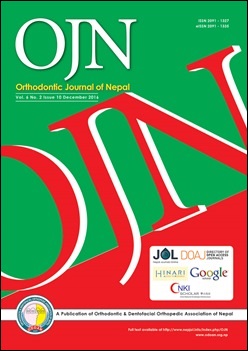Distribution of different Skeletal pattern in Patients seeking Orthodontic Treatment in Mid-western Nepal
DOI:
https://doi.org/10.3126/ojn.v6i2.17412Keywords:
anterio-posterior jaw base, cephalometric, skeletal jaw base relationshipAbstract
Objective: To determine the distribution of different skeletal pattern in orthodontic patients visiting a tertiary center in midwestern Nepal.
Materials & Method: A sample of 200 lateral cephalograms of Nepali patients visiting UCMS-College of Dental Surgery, Bhairahawa was obtained. The jaw base relationship was assessed from lateral cephalograms using angular measurement (ANB angle). Among the total sample size; 74 (37%) were males and 126 (63%) were female. Age was divided into 3 groups: 8-11 years, 12-17 years, and 18-36 years. Pearson Chi square test was done to test the association between age group and distribution of skeletal jaw base relationship. All data were recorded and analyzed with SPSS software.
Result: The distribution of skeletal malocclusion according to ANB angle classification revealed that the most prevalent skeletal malocclusion was Class II skeletal jaw base relationship accounting up to 97(48.5%), followed by Class I 87(43.5%) and Class III 16(8%). The study showed statistically significant difference between gender and distribution of skeletal jaw base relationship (p<0.05). However, there was no significant difference between the age groups and distribution of skeletal jaw base relationship (p<0.05).
Conclusion: Most common skeletal jaw base relationship in patients seeking orthodontic patients was Class II followed by Class I and Class III in a tertiary center of mid-western Nepal.
Downloads
Downloads
Published
How to Cite
Issue
Section
License
Copyright © held by Orthodontic & Dentofacial Orthopedic Association of Nepal
- Copyright on any research article is transferred in full to the Orthodontic & Dentofacial Orthopedic Association of Nepal upon publication in the journal. The copyright transfer includes the right to reproduce and distribute the article in any form of reproduction (printing, electronic media or any other form).
- Articles in the Orthodontic Journal of Nepal are Open Access articles published under the Creative Commons CC BY License (https://creativecommons.org/licenses/by/4.0/)
- This license permits use, distribution and reproduction in any medium, provided the original work is properly cited.




